

Mrs. Trinity Saioo also known as Turmeric Trinity is from Mulieh village, West Jaintia Hills District, Meghalaya. She is working with the Lakadong Variety of turmeric and assists the unread women in learning the methods of organic farming to boost their earnings. Today she is working with more than 900 farmers and probably touching thousands. She was presented with the fourth highest civilian award ‘Padma Shri’ for leading turmeric farming.
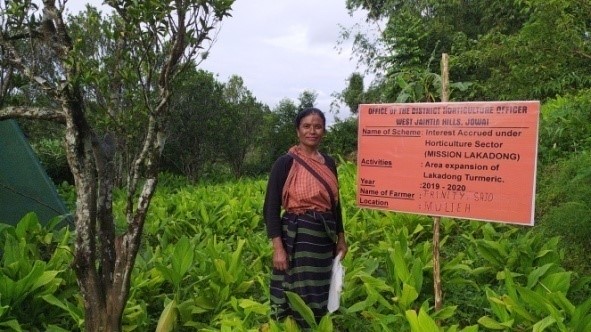
One of Ms. Trinity Saioo’s turmeric cultivation area in Mulieh village, West Jaintia Hills District, Meghalaya
Mrs. Trinity Saioo initially started farming to support her family, in addition to being a part-time farmer, she is also a teacher at a village school in her district. However, with time, her interest in the farming sector encouraged her to share her knowledge with the farmers in her district about the importance of organic farming of Lakadong turmeric and thereby enabling the farmers to triple their income. Mrs. Trinity Saioo is known for her ‘Selfless work’ towards uplifting the livelihoods of the farmers in her district.
The Spices Board of India made some major contributions in helping her to educate, preserve and promote the growth and cultivation of turmeric in the region through the provision of training programs, seminars, study tours, etc. Presently, she is also been a member of the Spices Board since 2013 till date.
Initially, it was Lakachin variety of turmeric that was grown in Mulieh village, however, when Mrs. Saioo came to know of a much superior quality of turmeric, i.e., the Lakadong turmeric, she started putting more efforts in creating awareness among the farmers of the importance of cultivation this particular variety. It was finally in the year 2003 that the cultivation of this variety got a boost through the subsidies received under the Spices Board.
To attain a profitable income from turmeric, Mrs. Saioo engaged the women of the village in the grading, processing of turmeric and this ultimately led to better marketing of turmeric and its value-added products. With the help of the ‘Mission Lakadong’ which was launched by the Government of Meghalaya in the year 2018, Mrs, Saioo seeks to multiply the production of Lakadong turmeric by leaps and bounds to reach the targeted quantum of 50,000 MT by the year 2023 and thereby to increase its market footprint across the country with and without governmental support.
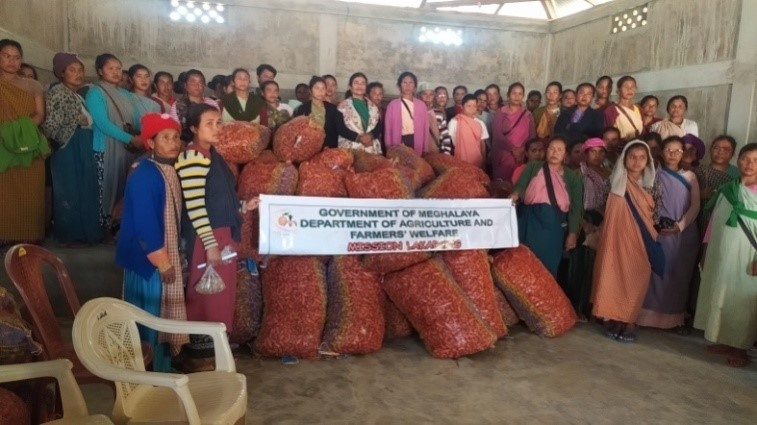
Awareness Program for Lakadong Mission followed by distribution of turmeric rhizome to the farmers
Today there are about 100 Self Help Groups associated with the Life Spice Federation of which Mrs. Trinity Saioo holds the post of Assistant General Secretary. The efforts of Mrs. Saioo have enabled her to extend her marketing networks to several states across the country like Kerala, Karnataka, Haryana, Punjab, West Bengal, Maharashtra, Assam, Mysore, Bihar, Uttar Pradesh, etc. Her aim going forward is to reach out to overseas markets as well.
Mrs. Trinity Saioo was honoured with the 'Excellence in Horticulture' award by the Ministry of Agriculture and Farmer’s Welfare, Government of India on the occasion of Women’s Farmers Day 2018. The Government of India honoured Mrs. Saioo with the Padma Shri award in 2020 for her invaluable contribution to the cultivation of turmeric and to promote farming.

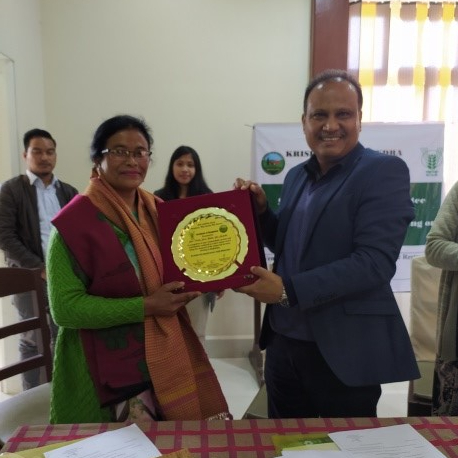
Received Award of Appreciation from Krishi Vigyan Kendra, Jaintia Hills Meghalaya, 2020
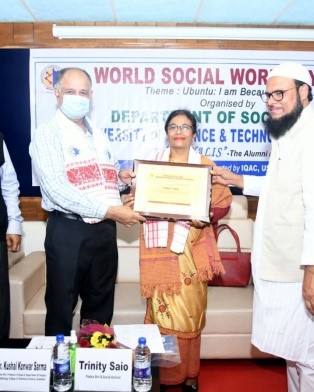
Received the Social Work Excellence Award, 2021 from the Department of Social Work, University of Science & Technology, Shilllong
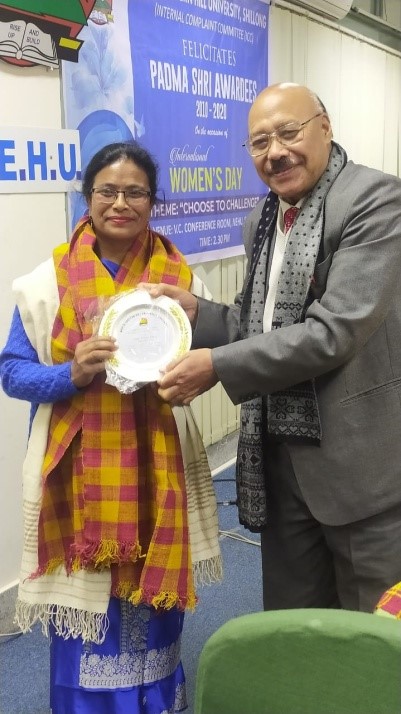
Fecilitated by North Eastern Hill University, Shillong for being a recipient of Padma Shri on Womens Day, 2021
(Content shared by Directorate of Food Processing, Government of Meghalaya)
About Lakadong Turmeric Powder Processing
The production of the high-value Lakadong Turmeric powder requires a series of unit operation right after harvesting of the Rhizome.
Harvesting of Lakadong Turmeric Rhizome
It normally takes nine months for Lakadong turmeric to be ready for harvest, depending on the time the crop is sown in the field. Normally, the harvest takes place between December and February. Harvesting is done manually by lifting the rhizomes clump using a crowbar and second harvesting happens during ploughing of the land using a spade. The uprooted rhizomes are hand-picked or the clumps are carefully lifted from the soil, without damaging the rhizomes.
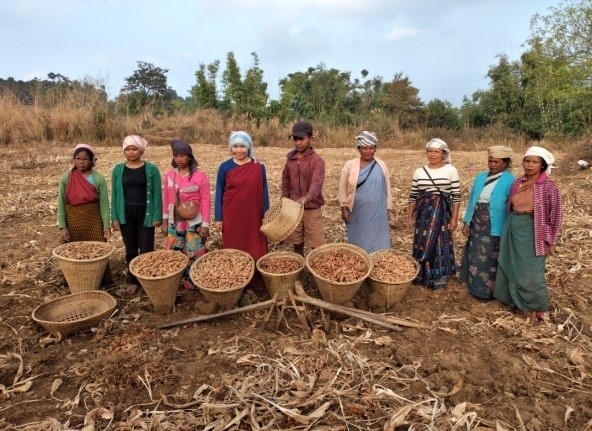
Harvested Turmeric
Sorting and Cleaning of Rhizome
The harvested rhizomes are cleaned manually to remove mud and any other extraneous matter. The rhizomes are separated into mother rhizomes and finger rhizomes. Usually, the mother rhizomes are stored which will be used as seeds for the next season planting while the finger rhizomes are used for processing into different forms like flakes, powder, and extractions.
Fingers rhizomes after sorting are washed to remove the soil particles and soil microflora, which stick to the surface of the rhizomes or enter into the small pores of the raw rhizome. At the Thadlaskein turmeric processing unit, fresh rhizomes are washed with a power-operated Roller Scrubber having a capacity of 400 kg/hr. Rhizomes are loaded in the drum through the opening provided on the upper surface of the drum and after the rollers are rotated, the adhering earth on the surface is washed away and collected at the other end of the drum.
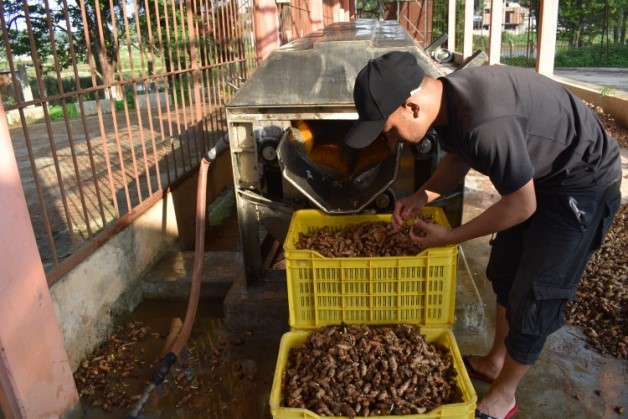
Washing of Turmeric rhizomes
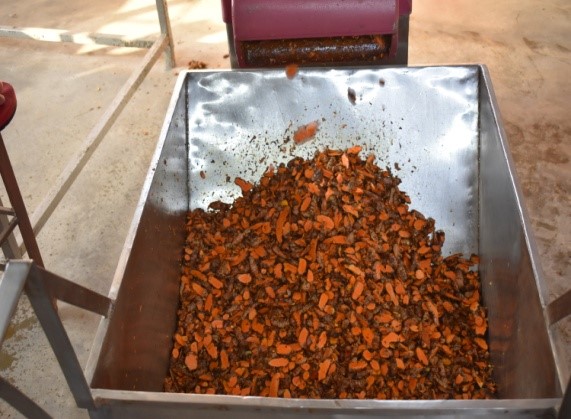
Slicing of Turmeric rhizome
The washed rhizomes are cut into thin slices manually with knives or with a power-operated slicing machine with the capacity to slice about 300-400kg per hour with the thickness of slices of 3mm.
Drying of sliced Rhizome
The slices rhizomes are dried either with a Solar dehydrator, Power-operated tray dryers or under the poly house which takes about 3-5 days, 10 hours, and 6-10 days respectively to attain a moisture content below 12%.
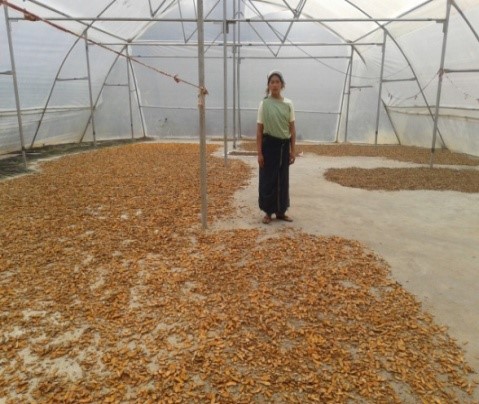
Drying under poly house
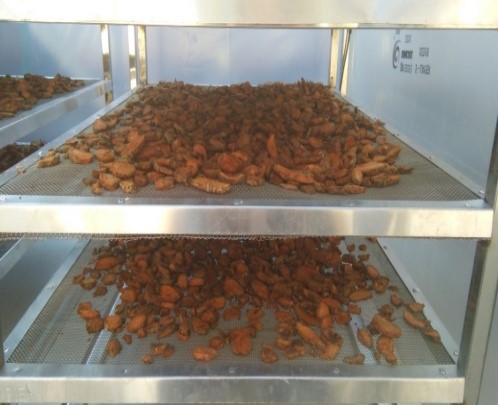
Drying in solar hybrid dehydrator
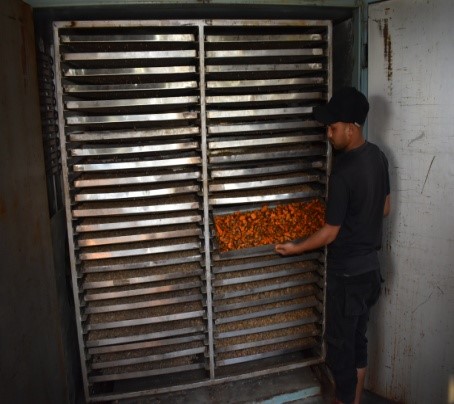
Drying in electric dryer
Dried turmeric slices are stored in a polythene bag, sealed, and then put inside a jute bag to avoid microbial infection. It is then stored in a dry place and ready to be marketed.
Grinding and packaging of Turmeric Powder
Dried turmeric slices are grounded into a fine powder by Turmeric grinding machine.
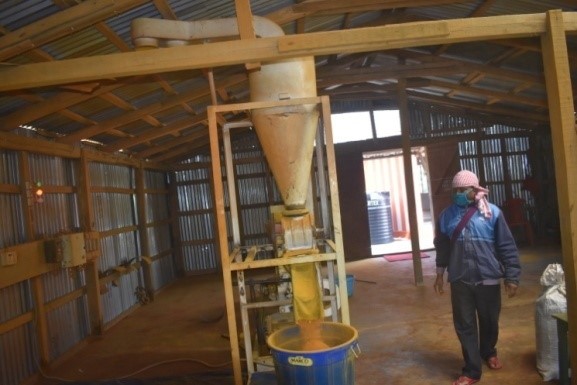
Grinding of Turmeric
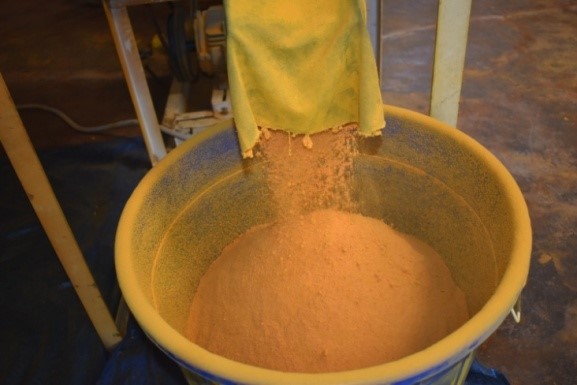
Collection of ground Turmeric
The ground turmeric is then filled manually in a pouch followed by sealing and packing using a hand-operated sealing machine in food-grade plastics or containers of different sizes with proper labels.
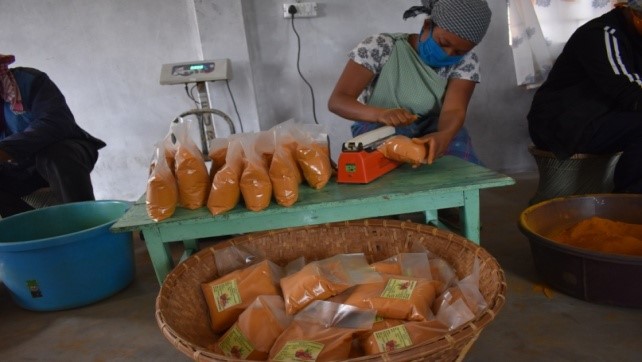
Sealing and Packaging of Turmeric powder

Packed Lakadong Turmeric Powder
The entire processes of processing from harvesting to packaging and the infrastructure, the types of machinery and equipment used should comply with FSSAI standards.
(Content shared by District Horticulture Officer, West Jaintia Hills, Jowai, Meghalaya)